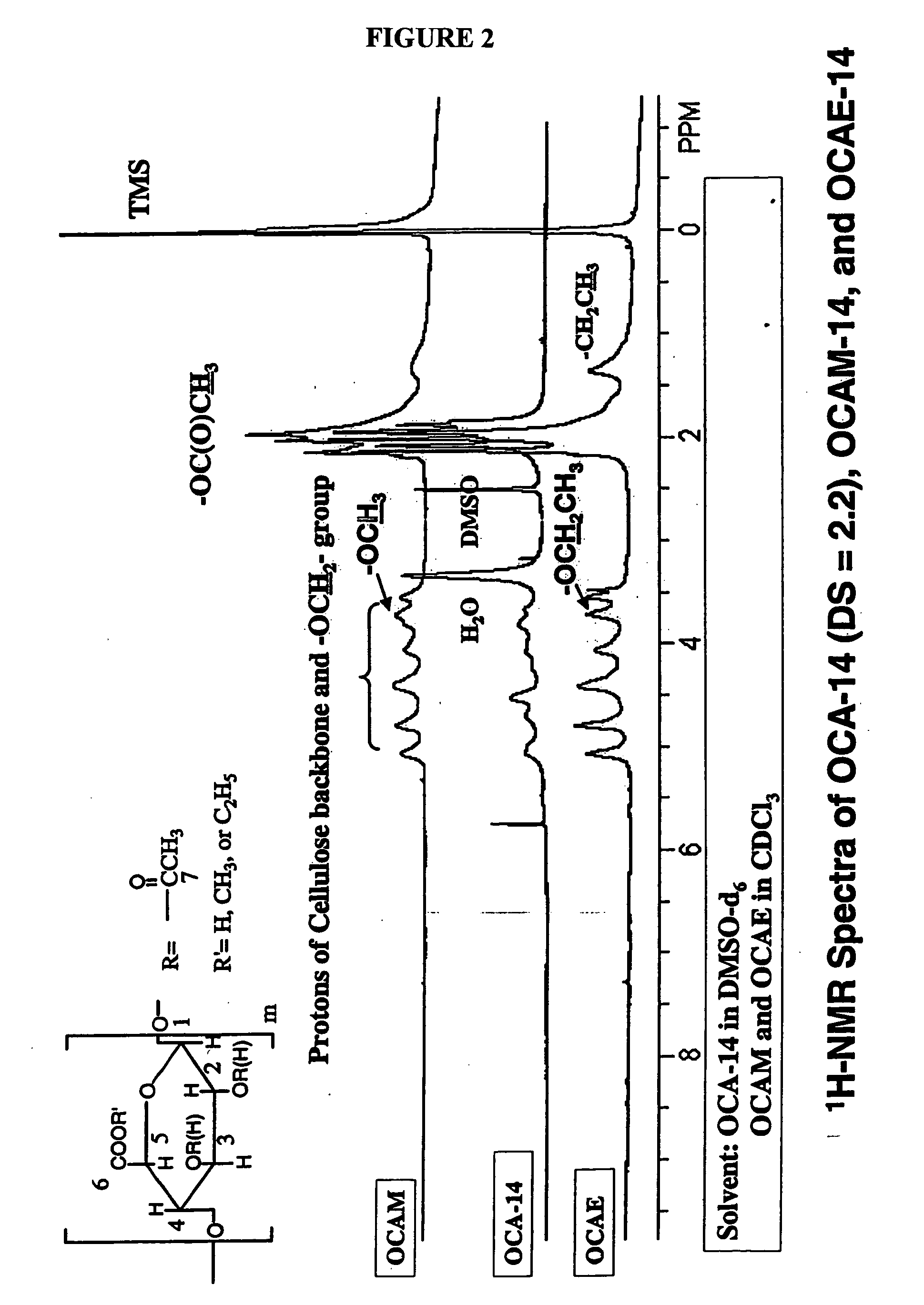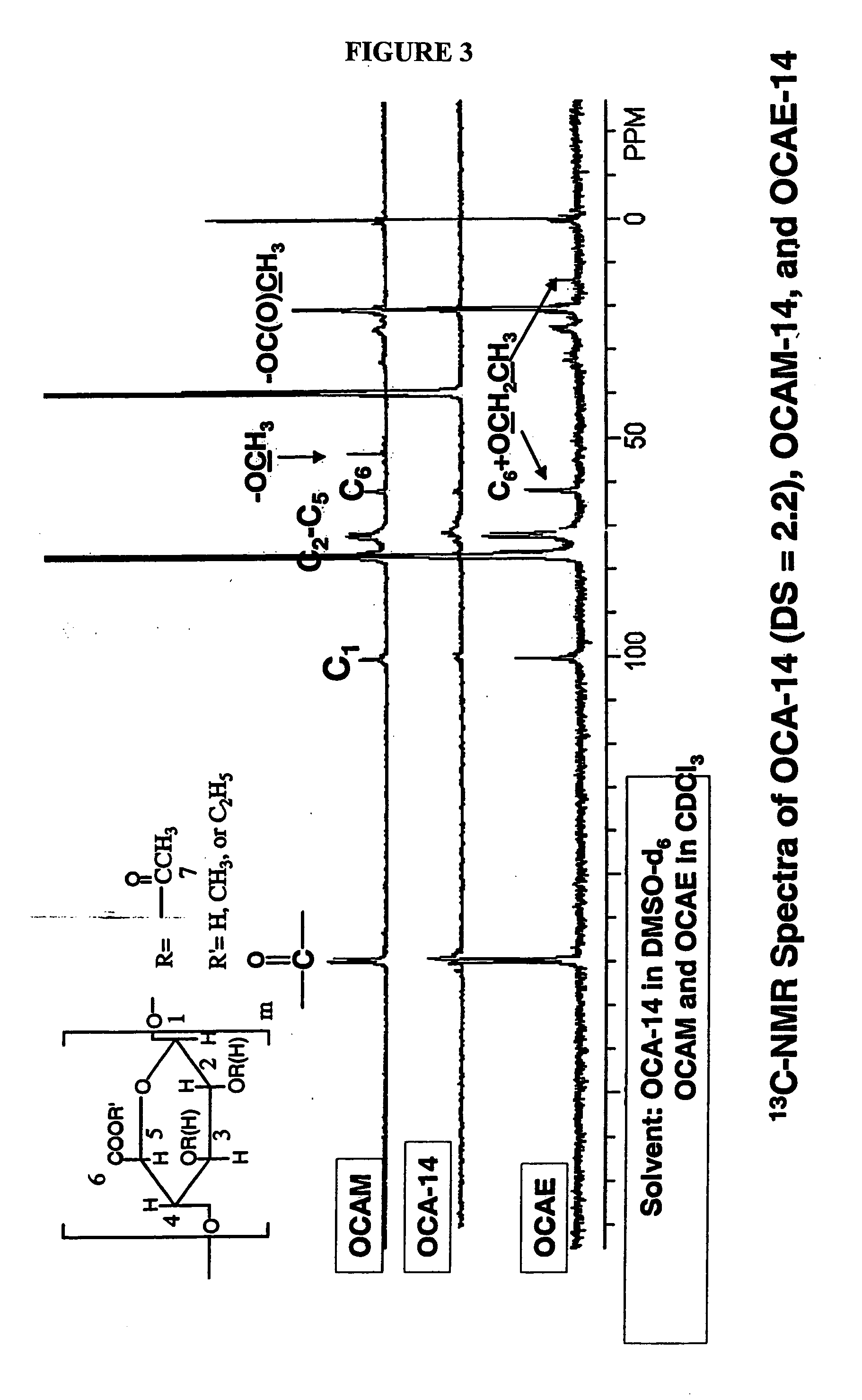Biodegradable oxidized cellulose esters and their uses as microspheres
a technology of oxidized cellulose and esters, which is applied in the direction of microcapsules, capsule delivery, granular delivery, etc., can solve the problems of little or no formulation flexibility, little use of oc in pharmaceutical applications, etc., and achieve the effect of prolonging the duration of release and increasing the substitution degr
- Summary
- Abstract
- Description
- Claims
- Application Information
AI Technical Summary
Benefits of technology
Problems solved by technology
Method used
Image
Examples
example 1
Preparation of Oxidized Cellulose Acetate Alkyl Esters
Materials
[0074] The starting material oxidized cellulose acetate (OCA) was prepared from oxidized cellulose (OC) by treatment with a mixture of acetic acid and acetic acid anhydride in the presence of catalytic amounts of concentrated sulfuric acid, in accordance with U.S. Ser. No. 10 / 007,866, filed Dec. 6, 2001. OC was prepared from a reaction between cotton linter sheet (Grade R 270; Southern Cellulose Products, Inc., Chattanooga, Tenn.) and a mixture of phosphoric acid (85% w / w), nitric acid (69.9% w / w) and sodium nitrite at room temperature for different time periods (See U.S. Pat. No. 6,627,749, Sep. 30, 2003, the disclosure of which is herein specifically incorporated by reference.
[0075] 1,3-dicyclohexylcarbodiimide (DCC) and 4-(dimethylamino)pyridine (DMAP) were obtained from Aldrich Chemical Co. (Milwaukee, Wis.) and used as a coupling agent and as a catalyst, respectively.
Methods
Synthesis of Methyl Ester of Oxidi...
example 2
Preparation of OCA and OCA Alkyl Ester-Camptothecin Microspheres
Experimental Section
Reduction of the Drug Particle Size
[0086] The particle size of pure camptothecin (CPT) and 5-fluorouracil (5-FU) was reduced by grinding the drug with a pestle and mortar gently.
Preparation of OCA 14-Camptothecin Microspheres
[0087] About 200 mg of CPT was accurately weighed and suspended in 70 ml of a 6:1 (v / v) mixture of methylene dichloride:methanol. To this, 2.5 g of OCA-14 was added. The mixture was stirred until OCA-14 completely dissolved in the solution. The resulting solution was then added drop-wise using a syringe over a period of 15 minutes to 300 ml of 1% (w / v) solution of poly(vinyl alcohol) (PVA) in water with vigorous stirring (˜715 r.p.m.) at room temperature. The stirring was continued at the same speed for an additional 5 minutes. The mixture was then allowed to stir at a slower speed (˜30 r.p.m.) for 4 hours to remove the organic solvents. The microspheres formed were separ...
example 3
Preparation and Characterization of OCA Alkyl Ester 5-FU Microspheres
[0092] 5-Fluorouracil (5-FU) was introduced 30 years ago as a synthesized anticancer agent. It still continues to be widely used in the treatment of several common malignancies including colon cancer, breast cancer, and skin cancer. It is an analog of the naturally occurring pyrimidine uracil. It is more acidic than its natural pyrimidine analog and is also more soluble in aqueous solutions. It is stable in solution at physiological pH for weeks. It is a poorly absorbed drug after oral administration with erratic bioavailability. The parenteral preparation is the major dosage form, used intravenously (bolus or continuous infusion). After parenteral administration of 5-fluorouracil, there is a rapid distribution of the drug and rapid elimination with an apparent terminal half-life of approximately 8 to 20 minutes. In order to maintain therapeutic concentrations of the drug in the blood, long term infusion has thusf...
PUM
| Property | Measurement | Unit |
|---|---|---|
| Temperature | aaaaa | aaaaa |
| Time | aaaaa | aaaaa |
| Time | aaaaa | aaaaa |
Abstract
Description
Claims
Application Information
 Login to View More
Login to View More - R&D
- Intellectual Property
- Life Sciences
- Materials
- Tech Scout
- Unparalleled Data Quality
- Higher Quality Content
- 60% Fewer Hallucinations
Browse by: Latest US Patents, China's latest patents, Technical Efficacy Thesaurus, Application Domain, Technology Topic, Popular Technical Reports.
© 2025 PatSnap. All rights reserved.Legal|Privacy policy|Modern Slavery Act Transparency Statement|Sitemap|About US| Contact US: help@patsnap.com



